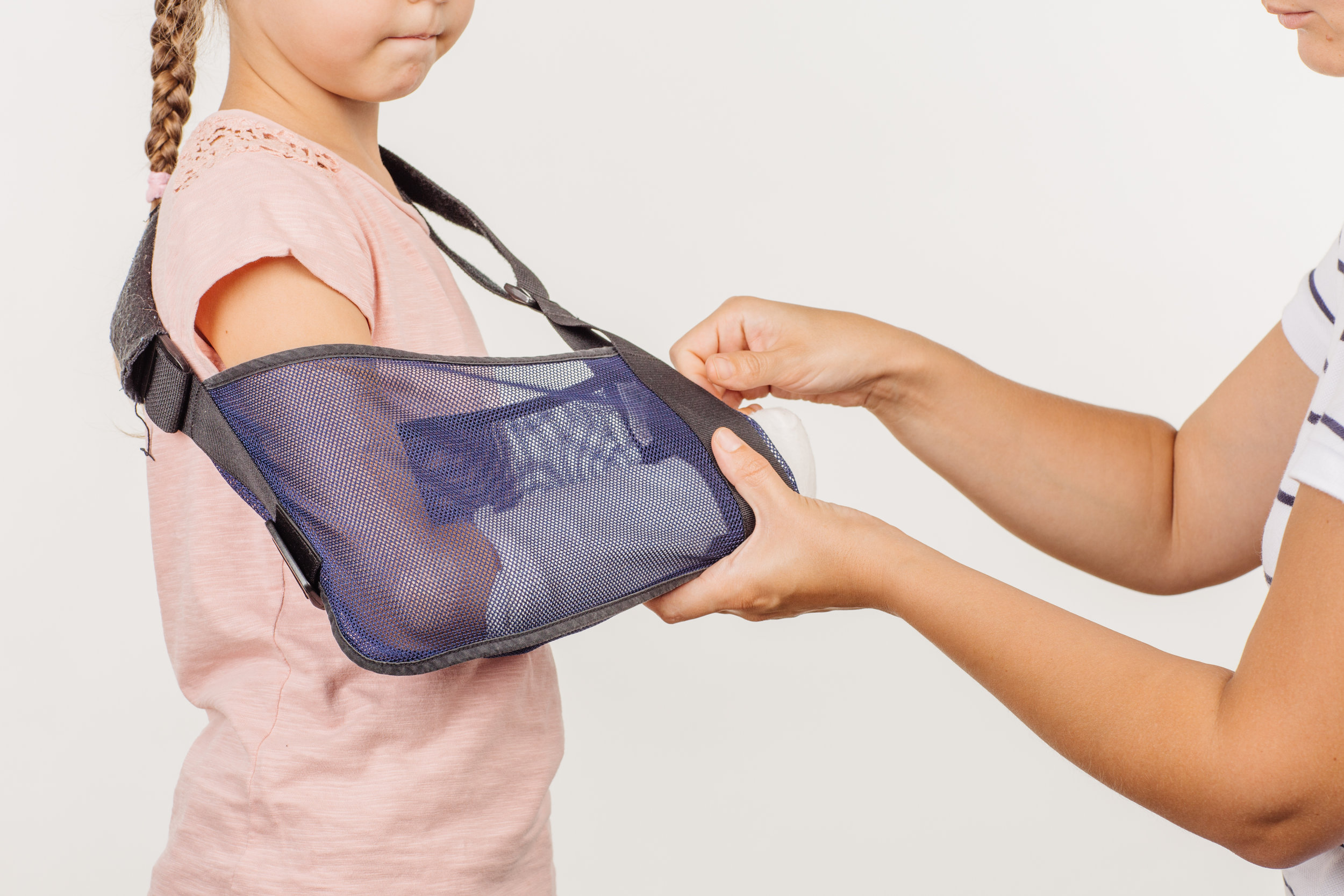KID'S FOREARM FRACTURE
The forearm contains two bones – the radius and ulna bones – which extend from the elbow to the wrist. The radius bone (along the thumb side of the forearm) has a bow, or curve, along the length of the bone that allows it to rotate around the straighter ulna bone (pinkie finger side of forearm). A broken (or fractured) forearm can involve either one or both of these bones. Fractures at the ends of the forearm can sometimes injure the neighboring wrist or elbow joint. Treating a forearm fracture appropriately is important for maintaining pain free and full motion of the elbow, forearm, and wrist.
In kids, sometimes the radius and/or ulna bone will break but not shift. The bend in the bone is often called a “greenstick” fracture, in reference to a young twig, which can be easy to bend but difficult to break. Sometimes, especially in older children, the broken forearm bones will shift, or displace. The severity of the displacement and the age of the child determine the best treatment plan.
Causes
Forearm fractures in kids usually result from a fall onto an outstretched arm combined with a rotational force through the forearm. Monkey bars, playground equipment, scooters, bikes, and sports are common culprits, as they produce higher energy falls and torque that can cause the bone to break.
Diagnosis
Forearm fractures result in pain, swelling, and decreased motion. More severe fractures can result in an obvious deformity of the arm.
X-rays are essential for a diagnosis and to determine the optimal treatment plan. The younger the child, the more years of growth they have remaining, and the more likely an angulated (or crooked) bone will straighten itself with normal growth.
Treatment
Cast or Splint
When a forearm fracture has a break in the bone that is not bent, rotated, or shifted, the broken bone(s) can oftentimes be treated in a plaster splint or cast. Splints provide less support than a hard cast, but they allow for more swelling. If placed initially, these are oftentimes changed to a hard fiberglass cast once swelling subsides. For a broken forearm, both the elbow and wrist must be included in the cast.
Fractures take ~6 weeks to heal, but this can vary based on the location, severity, and age of the child. Older children with more shifted fractures can take 3 months to heal.
Setting a fracture
An angulated forearm fracture treated with setting the bone and applying a waterproof cast.
In some forearm fractures, the bone breaks and becomes “displaced”. When a forearm fracture is bent, rotated, or shifted, sometimes the bones will need to be “set” or “reduced” to realign them and allow for optimal healing.
If a forearm bone heals in a bent position, it can limit rotation of the forearm (ability to turn the palm up and down).
Some displaced fractures will straighten themselves over time, especially in younger kids (<5 years old). Older kids may benefit from having the bone straightened by manipulating it, either in the office or in an operating room.
After setting the bone, a plaster splint or fiberglass cast is applied to hold the fracture in place while the body heals.
Typically the cast is left in place for ~6 weeks. After the cast if removed, a removable brace may be temporarily used as kids gradually return to normal activities.
Angulated fracture of the radius bone, which was set (reduced) to eliminate the bend. The arm was casted for 6 weeks, which allowed the radius to heal in a normal position.
Surgery
More severe fractures, with more notable displacement (bend, rotation, or shifting of the bones), may occasionally be treated surgically.
Surgery is sometimes required when either the bone can not be set or when the child is older (>10 years old). The growth through the forearm has largely finished by the time a girl is 13 or a boy is 15. Older children have less growth remaining, and less ability to straighten a shifted bone with normal growth. Additionally, as a child gets older, the “periosteum” – a normal soft casing around the bone – thins out and provides less stability. With a thinner periosteum, the bone is more likely to shift or displace during healing.
Surgery for forearm fractures typically involves placing a thin metal (titanium) plate and screws to hold the bone aligned. One advantage of surgery is that it can speed up the healing. Oftentimes kids can start using the arm for light activities 2-3 weeks after surgery, as the metal plate and screws hold the bones in place as the body mends the break.
Some fractures, especially in older kids, can be very challenging to properly align in a cast. Older kids (>10 years old) have less growth ahead of them, and therefore have less ability to “remodel”, or straighten, a fracture over time. In some severe fractures, surgery may be recommended to align the bone, which is then held with a small metal plate and screws.
Example 2. This child had fractured the forearm 3 times through the same location over a 2 year period. Another attempt was made at reducing/setting and casting. Unfortunately, given the obliquity (sloped angle) of the fracture, it continued to slide. A decision was made to align the broken forearm and hold in place with a metal plate and screws.
“I broke my arms this summer and Dr. Schreiber fixed them up perfectly. Nice guy and a great doctor!! Dr. Schreiber was extremely kind, knowledgeable, professional, and he took great care of me. The scars look great too! We highly recommend him!!”
“Outstanding doctor who helped us make a great decision for our daughter’s broken arm. Great results!”
Dr. Schreiber is a board certified orthopedic surgeon specializing in hand, wrist, and elbow conditions. Dr. Schreiber practices at the Raleigh Orthopaedic Clinic in Raleigh, North Carolina.
